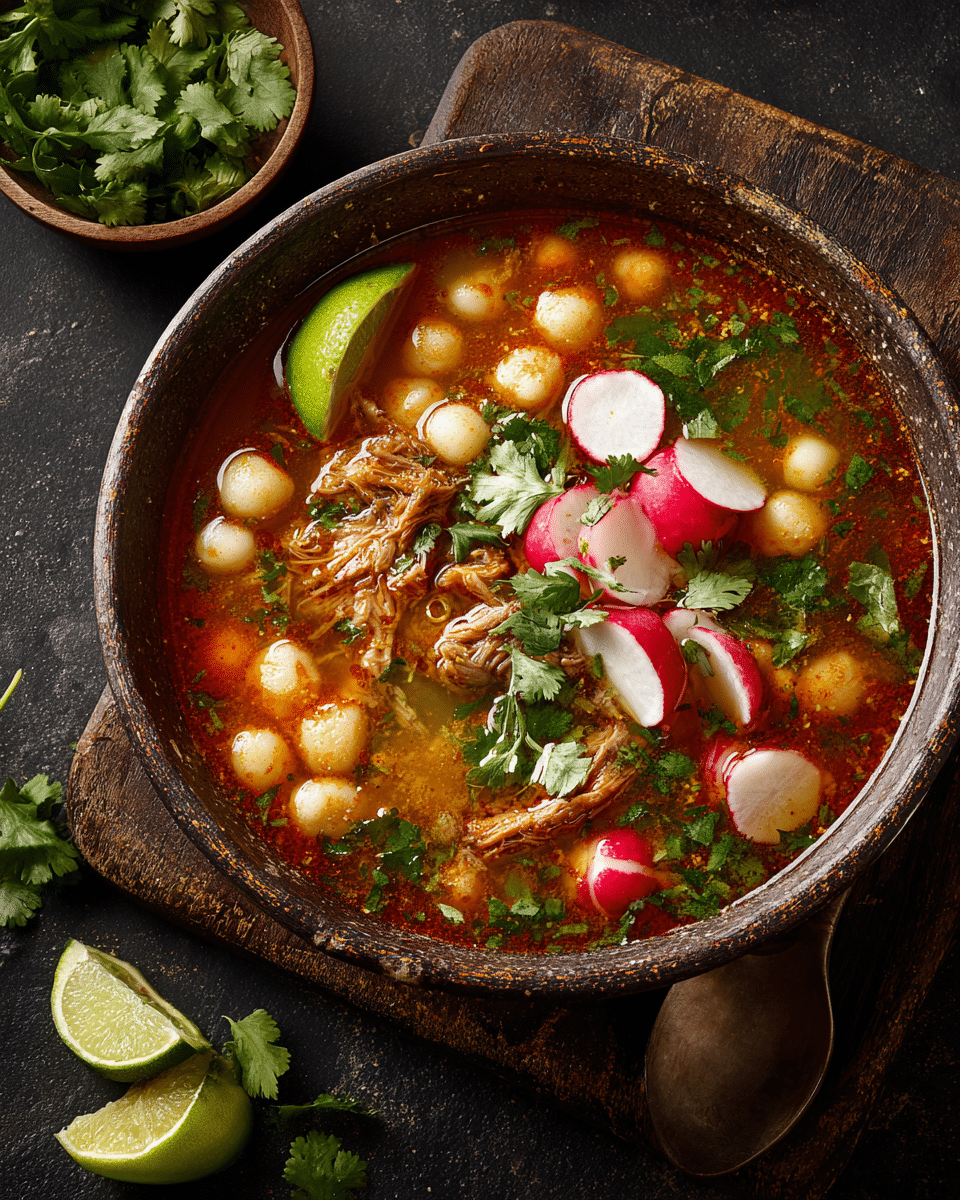Pozole is a traditional Mexican soup that is especially popular during festive celebrations, such as Mexican Independence Day. It features hominy large, chewy corn kernels simmered with either a rich red chile sauce (Pozole Rojo) or a vibrant green tomatillo and chile blend (Pozole Verde).
FULL RECIPE
Ingredients
1.For the Soup Base:
- 2 lbs pork shoulder or pork butt, cut into large chunks (or chicken for a lighter version)
- 12 cups water
- 2 bay leaves
- 1 medium white onion, halved
- 6 cloves garlic, peeled
- 2 tsp salt (adjust to taste)
- 2 cans (29 oz each) white hominy, drained and rinsed
2.For Pozole Rojo Sauce:
- 4 dried guajillo chiles, stemmed and seeded
- 3 dried ancho chiles, stemmed and seeded
- 1 dried pasilla chile (optional), stemmed and seeded
- 2 cloves garlic
- 1 cup chicken or pork broth (from the soup base)
- Salt to taste
3.For Pozole Verde Sauce:
- 8 medium tomatillos, husked and rinsed
- 3 serrano or jalapeño chiles (adjust to spice preference)
- 1 cup fresh cilantro leaves
- 1 cup fresh spinach or romaine lettuce leaves
- 2 cloves garlic
- 1 cup chicken or pork broth (from the soup base)
- Salt to taste
4.Garnishes
- Shredded cabbage or lettuce
- Sliced radishes
- Chopped white onion
- Fresh cilantro leaves
- Lime wedges
- Dried oregano
- Crushed red pepper flakes
- Crispy tostadas or tortilla chips
Directions
- Prepare the Soup Base:
Place the pork, water, bay leaves, onion, garlic, and salt in a large pot. Bring to a boil, then reduce to a simmer. Skim off any foam that forms on top. Simmer uncovered for about 1.5 to 2 hours, or until the meat is tender. Remove pork and shred into bite-sized pieces. Strain the broth, discarding the solids, and return it to the pot. Add shredded pork and hominy. Keep at a low simmer. - Make the Pozole Rojo Sauce:
Place dried chiles in a bowl and cover with hot water. Let soak for 15–20 minutes until softened. Drain and place in a blender with garlic, 1 cup reserved broth, and salt. Blend until smooth. Strain sauce to remove skins and seeds, then add to the soup base. Simmer 20–30 minutes to let flavors meld. - Make the Pozole Verde Sauce:
Boil tomatillos and chiles in a pot of water for 5–7 minutes until softened. Drain and place in a blender with cilantro, spinach, garlic, 1 cup reserved broth, and salt. Blend until smooth. Strain if desired, then add to the soup base. Simmer 20–30 minutes to blend flavors. - Serve:
Ladle pozole into bowls and let guests add garnishes to their liking—fresh cabbage, radishes, onion, cilantro, lime juice, oregano, and a sprinkle of red pepper flakes. Serve with crispy tostadas or tortilla chips on the side.
Nutrition Facts
- Calories: 320
- Protein: 22g
- Total Fat: 12g
- Saturated Fat: 4g
- Cholesterol: 70mg
- Carbohydrates: 33g
- Fiber: 6g
- Sugars: 4g
- Sodium: 780mg
Cultural Significance of Pozole
Pozole is one of Mexico’s most iconic dishes, deeply tied to its history and traditions. It dates back to pre-Hispanic times when it was prepared for ceremonial purposes, often served during religious festivals. Today, it has become a celebratory meal, especially popular during Mexican Independence Day and other national holidays. The dish’s symbolism lies not only in its vibrant colors—red, white, and green, mirroring the Mexican flag—but also in the way it brings people together. Sharing pozole is an act of community and family bonding, reinforcing its importance beyond being just a hearty soup.
Nutritional Profile and Health Benefits
Pozole offers a balanced combination of protein, carbohydrates, and fiber, especially when prepared with lean pork or chicken and plenty of fresh garnishes. Hominy, the core ingredient, is a good source of complex carbohydrates and dietary fiber, which support digestive health and sustained energy. The chiles, tomatillos, and vegetables used in pozole are rich in antioxidants, vitamin C, and minerals like potassium. By controlling the amount of oil and sodium, it’s possible to make a nutritious version that still maintains its authentic flavor.
Flavor Profiles of Red and Green Versions
Pozole Rojo is characterized by its rich, smoky depth, coming from dried chiles like guajillo and ancho, which provide mild heat and earthy complexity. In contrast, Pozole Verde delivers a fresher, more herbaceous flavor, thanks to tomatillos, cilantro, and green chiles. While both versions share the comforting, corn-based backbone of hominy, their sauces give them unique personalities. Rojo tends to be warming and bold, perfect for cooler months, while Verde offers a bright and zesty profile ideal for spring and summer gatherings.
Regional Variations in Mexico
Different regions of Mexico have their own approach to pozole. In Guerrero, Pozole Verde reigns supreme, often enriched with pepitas (pumpkin seeds) for creaminess. Jalisco is famous for Pozole Rojo, made with pork and often topped with crisp tostadas. Some areas in the north prefer white pozole, seasoned simply with herbs and served with raw garnishes. Each version reflects the local produce, available spices, and cultural preferences, making pozole a true representation of Mexico’s culinary diversity.
Garnishing Traditions and Customization
One of pozole’s most enjoyable aspects is the customization of garnishes. Shredded cabbage or lettuce adds a crisp bite, radishes provide peppery freshness, while lime juice brings brightness to balance the rich broth. Dried oregano and crushed red pepper flakes offer aromatic and spicy enhancements. Serving garnishes on the side allows guests to create their perfect bowl, making the dining experience interactive and personal. This flexibility also ensures that the dish can be adapted for different spice tolerances and flavor preferences.
Serving and Presentation Tips
Pozole is best served in deep bowls to accommodate the generous broth and garnishes. To elevate the presentation, arrange garnishes in small, colorful bowls around the table, encouraging a family-style serving experience. For festive occasions, pairing the dish with Mexican textiles, clay bowls, and traditional spoons can enhance the cultural atmosphere. Serving tostadas or freshly fried tortilla chips on the side adds texture and makes the meal more filling.
Perfect Pairings for Pozole
While pozole is a complete meal on its own, it pairs beautifully with certain drinks and sides. A cool glass of agua fresca, like hibiscus (jamaica) or tamarind, can balance the richness of the soup. For those who prefer alcoholic beverages, a light beer or michelada complements the spice, while a crisp white wine like Sauvignon Blanc can enhance Pozole Verde’s freshness. As for sides, elote (Mexican street corn) or a simple avocado salad can round out the meal.
Storage and Make-Ahead Advice
Pozole is an excellent make-ahead dish because its flavors deepen as it rests. The broth and meat can be prepared a day or two in advance and stored in the refrigerator, with garnishes kept fresh separately. When reheating, bring the soup to a gentle simmer rather than a boil to preserve its texture and flavor. Pozole also freezes well—store it in airtight containers for up to three months, though hominy may soften slightly upon thawing.
Adapting Pozole for Different Diets
Pozole can be easily adapted to suit various dietary needs. For a lighter version, use skinless chicken breast or turkey instead of pork. Vegetarians can substitute mushrooms, jackfruit, or hearty beans for the meat, while still enjoying the rich flavors of the chile or tomatillo base. Those following gluten-free diets can rest assured that pozole is naturally gluten-free, as long as the broth and seasonings do not contain additives with gluten.
Common Mistakes and How to Avoid Them
A frequent mistake when making pozole is undercooking the hominy or using it straight from the can without rinsing, which can leave a starchy taste. Overly boiling the chile sauce can also lead to bitterness, so it’s best to simmer gently. Another issue is oversalting before the broth reduces—always season gradually and taste throughout the cooking process. Taking the time to strain sauces results in a smoother texture and a more refined final dish.
Conclusion
Pozole Rojo and Verde are more than just delicious Mexican soups—they are a cultural tradition, a festive centerpiece, and a dish that invites creativity. Whether you prefer the smoky warmth of red chiles or the bright tang of tomatillos and cilantro, pozole offers a comforting, customizable experience that brings people together. By understanding its history, regional differences, and versatile nature, you can prepare a version that suits your tastes while honoring its rich heritage.






